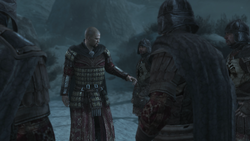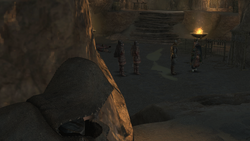
|
Ezio, my friend! How may I be of service? This article is in desperate need of a revamp. Please improve it in any way necessary in order for it to achieve a higher standard of quality in accordance with our Manual of Style. |
The Byzantine Empire, known contemporaneously as the (Eastern) Roman Empire, was the predominantly Greek and/or Hellenized continuation of the Roman Empire during Late Antiquity and the Middle Ages.
The Byzantine capital, Constantinople, was eventually conquered by the Ottoman Empire and fell into Ottoman control; until its collapse, the Byzantine Empire had been established for 1123 years.
History
Templar infiltration
During the early 16th century, after the Templars were driven from Italy by the Assassins, the members of the Templar Order were able to seize control of the remnants of the Byzantine Empire. Now in command, the Templars set up their primary headquarters at Derinkuyu in Cappadocia, where the Byzantines' ultimate aim was to uproot the Ottoman Empire and retake control of Constantinople. For a time, however, they remained relatively quiet.
Masyaf
By 1509, the Templars were aware of the five seals of Altaïr Ibn-La'Ahad. In this year, after an earthquake shook Constantinople, the Templars discovered one of the seals under Topkapı Palace, as the entrance to the seal's chamber had been opened by the seismic activity.
Following this discovery, the Byzantine Templars became more active and militant in their desire to retake Constantinople and find the remaining four seals. Shortly afterwards, this seal passed into the possession of the de facto Byzantine Emperor – the Templar in charge of the hunt for the seals – Manuel Palaiologos.

Leandros instructing Byzantine soldiers
By the beginning of 1511, a Byzantine Templar captain named Leandros had occupied the region surrounding Masyaf, where the library of Altaïr Ibn-La'Ahad was located, though by May 1511, the region had been cleansed of Templars by the Mentor of the Italian Assassins, Ezio Auditore da Firenze, who was visiting Masyaf to learn more of the Assassin Order.
By this time, the Templars were searching the Forum of the Ox and the Yerebatan Cistern in Constantinople for seals, though they were beaten to both of these seals by Ezio.
Constantinople

Two Byzantines in the Yerebatan Cistern
As the Templars plotted to overthrow the Ottomans, many Byzantine soldiers were present in Constantinople by mid-1511. These soldiers rivaled the Constantinople Assassins Guild, and by the month of May, they had seized all of the Assassin Dens for themselves aside from two, with them being one in Galata, and one in the Imperial District, near the Grand Bazaar.
Shortly after Ezio's arrival in the city, the Templars launched an attack on both of the remaining dens, and though they were routed at Galata, they managed to take the den at the Grand Bazaar. However, this would prove to be a temporary victory, as the Assassins retook the den shortly after. Over the 11 months that Ezio spent in the city, he managed to retake the dens one by one and severely weaken the Templars, until March 1512.
Following this, Ezio left for Cappadocia in search of Palaiologos, who possessed the last seal. Ultimately, Ezio killed Manuel and claimed the seal for himself, though, as he was about to leave, he noticed the Ottoman prince Ahmet on a ship with Byzantines, who revealed that he was the true mastermind behind the Masyaf expedition.
Cappadocia

Ezio eavesdropping on Manuel and Shahkulu
During the early 16th century, the Templars set up their headquarters in Cappadocia, after being driven from their previous base in Rome by the Assassins. There, the Templars set up prisons and instated themselves as the rulers of the city, filling the streets with Byzantine soldiers.
Palaiologos resided in Cappadocia for some time after his family lost their hold on the Byzantine throne. He, along with his bodyguard and fellow Templar, Shahkulu, governed much of the city and held power within its walls until Ezio's arrival.
Trivia
- The frequently spoken name "Byzantine" is an anachronism, as this name was given to the Eastern Roman Empire by later historians, in order to distinguish between it and ancient Rome. As such, the Byzantines would have referred to themselves as "Romans", "Greeks" and/or "Hellenes" (Romaioi, Graikoi and Ellines in Greek respectively) since they were the political continuation of the Roman Empire in the east, as well as the direct heirs and guardians of Hellenic civilization. Despite the word Byzantine first being used roughly 30 years after the events of Assassin's Creed: Revelations, and widespread use of the word not occurring until the 19th century, Manuel Palaiologos and many other characters still use the term, likely for the sake of audience recognition.
- Once Ezio had liberated all of the Templar Dens and completed the Master Assassin memories, Byzantine soldiers would rarely be encountered in Constantinople, aside from a few lingering patrols in the Constantine District, the bodyguards of Templar officials once notoriety was high enough, and patrols of Byzantines that would occasionally appear and ambush him (usually consisting of two or three militia and a Varangian).
Gallery
Reference









